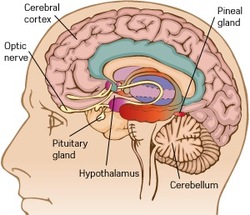Light-sensitive molecules deep in the brains of birds may underlie their ability to track the seasons

Photoreceptor molecules called Opsin 5 have been shown to help regulate seasonal hormone levels in Japanese quails, and may also be present in the human brain. The gene encoding Opsin 5 was found in the hypothalamus in association with neurons linked to the hormone-producing pituitary gland.
c iStockphoto/pukrufus
Many animals monitor the length of the day in order to keep track of the seasons. This phenomenon, known as photoperiodism, allows their physiology and behavior to adapt to seasonal changes in the environment, and indicates the most favorable times of year to produce offspring.
Now, a research team led by Takashi Yoshimura of Nagoya University's Institute for Advanced Research and GCOE for Advanced Systems Biology has identified a light-sensitive molecule, Opsin 5, that is expressed deep in the brain of birds and probably helps regulate seasonal reproduction1.
The retina and the pineal gland -- an organ in the brain that helps to modulate waking and sleeping patterns -- both sense light using light-sensitive molecules called photoreceptors. However, experiments performed by the Nobel Prize-winning scientist Karl von Frisch a century ago suggested that photoreceptors elsewhere in the brain might mediate skin color changes in fish.
"There is now strong evidence that such photoperiodic responses involve deep brain photoreceptors, but the identity of these molecules has been unclear," says Yoshimura.
To remedy matters, Yoshimura's team turned to an avian model system -- the Japanese quail. "Japanese quails show strong photoperiodic responses even when their eyes and pineal gland have been surgically removed," explains Yoshimura.
Previous experiments had shown that local illumination of deep brain areas, including a region of the hypothalamus, led to the growth of reproductive organs (gonads) in quails. Subsequent work suggested that the photoreceptors responsible might belong to a class of molecules called opsins.
To cast further light on the matter, Yoshimura and his colleagues searched the published genome of the chicken, a close relative of the quail, for DNA sequences encoding candidate opsins. They then examined the expression of opsin genes in the quail brain.
The researchers found that the gene encoding Opsin 5 is expressed in the paraventricular organ of the hypothalamus, and that the neurons expressing the molecule are structurally similar to photoreceptor cells found in the developing retina. Fibers from these neurons project into brain regions adjoining the nearby pituitary gland, which plays a central role in regulating hormonal levels in vertebrates and thereby helps to control reproduction.
"Our results strongly suggest that Opsin 5 is a deep brain photoreceptor involved in the seasonal regulation of reproduction in birds, although this needs to be confirmed through gene knockout studies," says Yoshimura. The researchers also note that Opsin 5 is expressed in the mammalian brain and retina, suggesting that the findings may be relevant to humans.
Affiliated Researchers
The Nagoya University affiliated researchers mentioned in this highlight are from the Institute of Advanced Research, the Graduate School of Bioagricultural Sciences and the GCOE for Advanced Systems Biology: Designing the Biological Function.
Reference
- Nakane, Y. et al. A mammalian neural tissue opsin (Opsin 5) is a deep brain photoreceptor in birds. Proceedings of the National Academy of Sciences USA 107, 15264-15268 (2010). | article